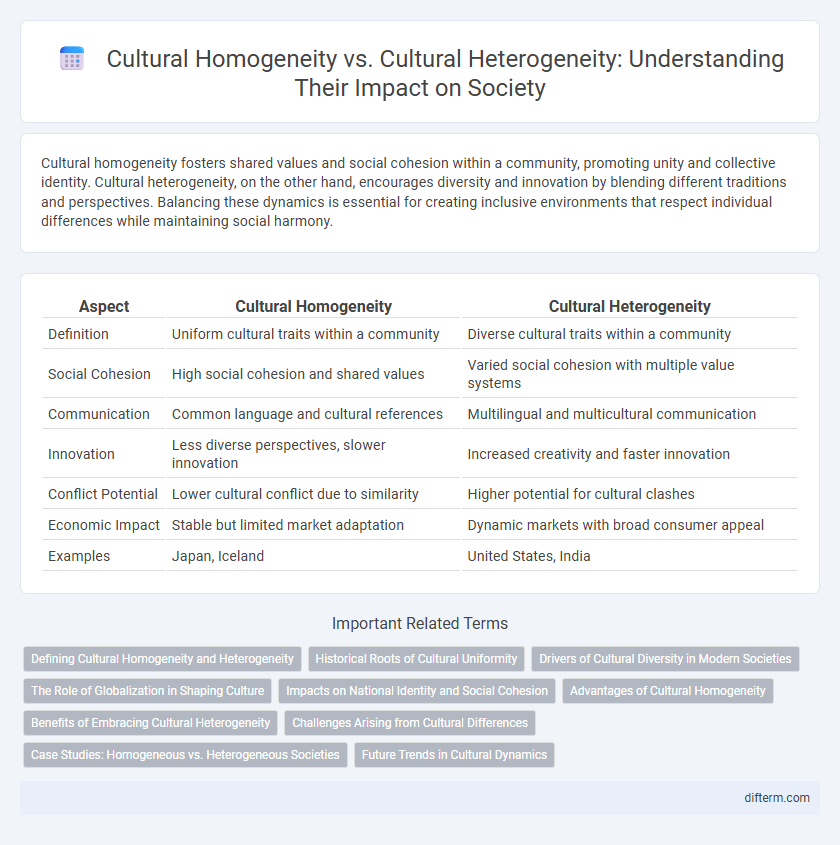Cultural homogeneity fosters shared values and social cohesion within a community, promoting unity and collective identity. Cultural heterogeneity, on the other hand, encourages diversity and innovation by blending different traditions and perspectives. Balancing these dynamics is essential for creating inclusive environments that respect individual differences while maintaining social harmony.
Table of Comparison
| Aspect | Cultural Homogeneity | Cultural Heterogeneity |
|---|---|---|
| Definition | Uniform cultural traits within a community | Diverse cultural traits within a community |
| Social Cohesion | High social cohesion and shared values | Varied social cohesion with multiple value systems |
| Communication | Common language and cultural references | Multilingual and multicultural communication |
| Innovation | Less diverse perspectives, slower innovation | Increased creativity and faster innovation |
| Conflict Potential | Lower cultural conflict due to similarity | Higher potential for cultural clashes |
| Economic Impact | Stable but limited market adaptation | Dynamic markets with broad consumer appeal |
| Examples | Japan, Iceland | United States, India |
Defining Cultural Homogeneity and Heterogeneity
Cultural homogeneity refers to a society or group characterized by shared values, beliefs, customs, and language, promoting social cohesion and uniformity. Cultural heterogeneity, in contrast, describes a diverse population with multiple ethnicities, languages, traditions, and practices coexisting, often leading to dynamic intercultural interactions. Understanding the distinctions between cultural homogeneity and heterogeneity is essential for analyzing social integration, identity formation, and policy development in multicultural settings.
Historical Roots of Cultural Uniformity
Cultural homogeneity often stems from historical processes like conquests, colonization, and centralized governance that promoted shared languages, religions, and traditions, reinforcing uniformity within societies. For example, the Roman Empire's extensive integration policies facilitated a common cultural framework across its territories, while nation-states like Japan maintained cultural uniformity through isolationist policies and a dominant ethnic identity. These historical roots of cultural uniformity shape contemporary social cohesion and influence national identities worldwide.
Drivers of Cultural Diversity in Modern Societies
Globalization, migration, and technological advancements serve as primary drivers of cultural diversity in modern societies by facilitating the exchange and blending of traditions, languages, and customs. Economic opportunities and political stability attract diverse populations, fostering multicultural urban environments and increasing cultural heterogeneity. Educational systems and media also play significant roles by promoting cultural awareness and the diffusion of diverse cultural expressions.
The Role of Globalization in Shaping Culture
Globalization accelerates cultural exchange, leading to both cultural homogeneity and heterogeneity by spreading dominant cultural norms while simultaneously promoting the preservation of local traditions. The integration of global markets, media, and communication technologies facilitates the blending of cultures, resulting in shared values and practices across nations. However, globalization also encourages cultural diversity by enabling marginalized groups to express unique identities and resist cultural homogenization.
Impacts on National Identity and Social Cohesion
Cultural homogeneity fosters a unified national identity by promoting shared traditions and values, which can enhance social cohesion and collective belonging. Conversely, cultural heterogeneity enriches societies with diverse perspectives and experiences, potentially challenging national identity but encouraging inclusivity and adaptability. Balancing these dynamics is crucial for policies that nurture social harmony and respect multiculturalism within a nation.
Advantages of Cultural Homogeneity
Cultural homogeneity fosters social cohesion by promoting shared values, traditions, and language, which enhances communication and understanding within a community. It simplifies governance and policy implementation as unified cultural norms reduce conflicts and misunderstandings. Homogeneous cultures often experience stronger collective identity and stability, aiding in maintaining social order and continuity across generations.
Benefits of Embracing Cultural Heterogeneity
Embracing cultural heterogeneity fosters innovation by integrating diverse perspectives and problem-solving approaches, which enhances creativity in organizations and societies. It promotes social cohesion and mutual respect, reducing prejudices and enriching cultural experiences through exposure to varied traditions, languages, and ideas. Economies benefit from a skilled, adaptable workforce that thrives on multicultural collaboration, driving global competitiveness and inclusive growth.
Challenges Arising from Cultural Differences
Cultural heterogeneity presents challenges such as communication barriers, differing social norms, and conflicting value systems that can hinder collaboration and social cohesion. Cultural homogeneity may reduce misunderstandings but risks limiting diversity and innovation, potentially causing stagnation in societal growth. Managing these challenges requires inclusive policies and intercultural competence to foster mutual respect and effective interaction across diverse cultural groups.
Case Studies: Homogeneous vs. Heterogeneous Societies
Homogeneous societies such as Japan often exhibit strong social cohesion and clear cultural norms, enabling streamlined policy implementation and collective identity. In contrast, heterogeneous societies like the United States tend to foster innovation and multiculturalism, though they may face challenges in social integration and political polarization. Case studies reveal that the balance between cultural homogeneity and heterogeneity significantly impacts societal resilience, economic development, and social harmony.
Future Trends in Cultural Dynamics
Future trends in cultural dynamics indicate a growing shift towards cultural heterogeneity driven by globalization, digital connectivity, and increased migration. Diverse cultural expressions and hybrid identities are expected to become more prominent as societies integrate multiple traditions and values. This evolution challenges the persistence of cultural homogeneity and fosters an environment of continuous intercultural exchange and innovation.
Cultural homogeneity vs Cultural heterogeneity Infographic

 difterm.com
difterm.com